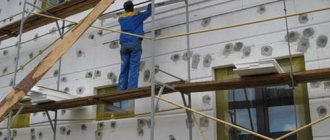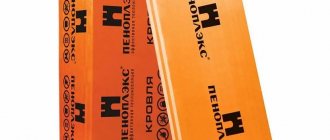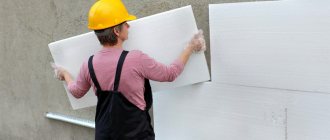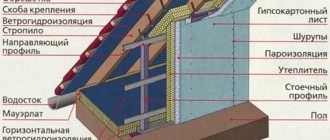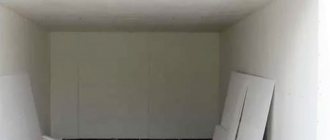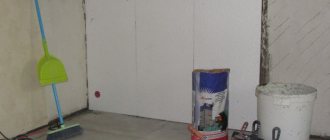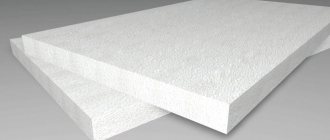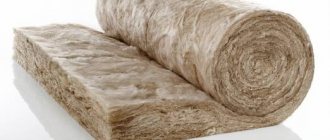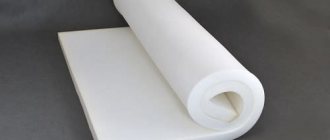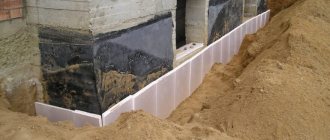The cost-effectiveness of insulating the facades of houses, warehouses, country cottages and other buildings has long been proven by experience in civilized and economically developed countries. In addition, facade decorative plasters, which can be used to insulate the facade, pleasantly please with their variety: Bark beetle, Fur coat (Lamb), Mosaic
and many others.
But, like any innovation, thermal insulation has managed to pick up rumors and misconceptions. The lack of reliable information on the insulation of facades of residential buildings leads to problems in the real operating conditions of the insulated facade. Also, the technology for performing work when insulating the facade is often violated. And even more often, an inexperienced end user manages to buy the wrong polystyrene foam, covet the low price of façade adhesive for polystyrene foam, choose a construction team of amateur façade designers...
It's time to dispel myths about facade insulation.
Insulating the facade is not profitable (expensive)
Those who think so are right in their own way.
After all, this is not exactly a cheap pleasure. But you get the opportunity to strengthen the walls, insulate your home, and decorate the facade in one fell swoop. And an insulated facade means the comfort and coziness of your home, the health of your family, the refined European style of your home, reliability and durability for many years. And the fact that after 5 years the same money will return to you by saving energy resources, and after that you will start “earning money”, generally renders this myth completely irrelevant. Myth No. 8.
Negative reviews about polystyrene foam
The following points are often mentioned.
When burning, poisons are released
And I have to agree with this. Because it has been tested in practice. There are many life examples described in various media. Cases where people received serious poisoning due to toxic substances released when burning polystyrene foam. Unfortunately, there were also tragic cases.
Harmful substances are also released at low temperatures
As a rule, in such negative reviews of polystyrene foam we are talking about styrene. This is a truly harmful substance that has a negative impact on people's health.
This release is especially stimulated by the sun's rays falling on the foam. Or when it is located in warm rooms (for example, a bathhouse, a kitchen). That is, when heating occurs.
Doesn't breathe well
This is talked about quite often (both online and offline). For example, when the walls of a house are insulated with foam plastic, it becomes difficult for water vapor to escape from the premises to the outside. Some reviews say that after insulating the house with this material, the microclimate in the rooms has clearly changed - the level of humidity has increased, it has become stuffy, and there is a regular desire to open the window and ventilate the room.
Let's not argue with this. Because we tested it in our own practice - foam plastic really doesn’t “breathe” well.
That is, in essence, this material creates a vapor barrier. Yes, there are ways to combat this (for example, a good ventilation system in the house). However, this negative point must be taken into account.
Destroyed in the sun
The thing is that ultraviolet rays quickly destroy the structure of the foam and simply “eat” it. First the material turns yellow, and then begins to crumble.
However, it should be noted that it is very easy to deal with this. To prevent this from happening and to ensure that polystyrene foam lasts a long time, it must be reliably protected from exposure to sunlight. For example, when insulating the walls of a house, glue and plaster are used for this.
These are the opinions we encountered. As you can see, not only good things are said about this material, but also bad things.
It doesn't matter what you use to insulate it
If you have the opportunity to control the quality of materials for facade insulation
polystyrene foam (and most often the performers of the work hide such information), then pay special attention to the following details: - the manufacturer of the mixture for gluing and reinforcing foam plastic - it must be a reputable brand at an affordable price.
Manufacturing plants ensure certification of their products, the required density, quality and reliability thanks to special production technology;
- quality of reinforcing mesh
- it can be low density, “over-scorched”, fragile or just Chinese
- the cost of a normal mesh is at least 1500 rubles. per roll of 50 meters;
- quality and variety of decor
- it is advisable to use domestic finishing materials using European production technologies;
Also, ask what type of decorative plaster the contractor included in the price:
- mineral (cheaper)
- or acrylic (more expensive);
Acrylic provides a stronger connection of small particles (grains) of plaster with each other and higher uniformity, compared to a dry mineral mixture, and is colored throughout the entire volume of the decor, which will ensure greater durability and color saturation.
Myth No. 10.
Some general information about polystyrene foam
This material is obtained by foaming plastic mass. Gas makes up its bulk, so the density of the resulting material is significantly lower than the density of the polymer.
In everyday life (and not only) we often deal with expanded polystyrene (pressless). It is widely used due to its high thermal insulation properties (98% of the material is gas in small cells).
The scope of application is truly extensive: in construction for insulation of various structures, including residential buildings; for the manufacture of all kinds of containers; in instrument making for thermal insulation (for example, refrigerators), etc.
It doesn't matter who does the insulation
Tile adhesive is much cheaper than thermal insulation adhesive and also glues polystyrene foam boards quite well... But after a month or two, the foam falls off the wall and is held in place only by mechanical fastening (umbrella dowels, perforated corners and base strips, if any were used in the process insulation of facades with foam plastic).
Many customers don't know this. And many performers make good money from this. The number of umbrella dowels per 1 square meter of foam should be 5-6 pieces. according to technology, and not 2-3 pieces, as many facade workers do, trying to save for personal gain. Before applying glue, the surface MUST be primed, and this is INCLUDED in the cost of insulating the facade with foam plastic! The decorative layer INCLUDES a primer paint based on quartz sand!..
Do you still think that it’s better than anything, as long as it’s cheaper?..
You might be interested in: Facade work The estimated cost of facade work in Rostov-on-Don and the Rostov region can be found in the “ prices ”
High-quality insulation of walls with foam plastic from the outside with step-by-step instructions
Even if a decision is made to insulate the walls, special tools are not always at hand. And this point also plays an important role when choosing the material with which these works will be performed.
As practice has shown, in order to install foam plastic on an external wall, you just need to adhere to a certain stage of work. Although there is an opinion about the simplicity of such work, irresponsibility can ruin all the work.
Stages of wall insulation with foam plastic:
1. Sheets of insulation are laid in a checkerboard pattern, so that the joint from one row falls in the middle of the sheet of the other row. All elements are carefully coated with glue.
Important! Choose glue with antifungal markings or add a special mixture to it.
2. If there are any unevenness on the butt seams, they need to be rubbed down to perfect condition.
Important! Even the smallest gap at the joint must be puttied.
3. We reinforce our structure to give it the required rigidity. To do this, we use a facade mesh, which we glue with a special mixture.
4. We strengthen it with a reinforcement mixture, which we apply in an additional layer after the reinforcing layer has dried.
5. We prime our walls.
6. We complete the work by applying a decorative layer: plaster, decorative slabs, facing bricks, etc.
It is important to know
Laying foam sheets directly on the ground is not allowed: waterproofing work must first be carried out, and then a layer of screed must be poured. Otherwise, the floor may be damaged by rodents.
If all rules of use are followed, the service life of foam plastic as insulation reaches 100 years. This is its undoubted advantage.
Compliance with the rules for using polystyrene foam as insulation makes it possible to save money on heating your home, and also get rid of excess noise. It can also protect from the sun's hot rays, while preventing the outside walls from heating up. Therefore, there is no need to regularly use the air conditioner, which allows you to save on electricity.
Characteristics
The production of polystyrene foam began more than eighty years ago. The first block was released in Germany, after which it began to be used everywhere in various territories. The basis for the insulation boards are polystyrene beads. Initially, they are elements with a dense structure that do not even remotely resemble foam plastic. At the first stage of production, they are foamed. Next, the base is dried and cured, which is subsequently immersed in a special chamber, where it is sintered with steam at a certain pressure. At the pre-sale stage, the foam comes in large blocks that are cut to specification.
The size of the standard sheet that is used for insulation is one meter long and wide; there are also options for a foam sheet with half the width. The most popular sheet size is 120 by 60 cm. The difference between types lies not only in size, but also in the density of the material. The normal density for insulating facades is 25 kg per cubic meter. Slabs with a density of 15 and 40 kilograms are also produced. This indicator directly affects thermal conductivity. The higher the number, the lower the thermal conductivity and the higher the price for the foam. Denser insulation can withstand greater loads, so it is often used for floor insulation.
Due to the fact that the balls undergo preliminary foaming, this saturates them with gas, which causes the low thermal conductivity of the foam. Its indicator is within 0.038 W/(m×K). Typically, polystyrene foam comes in white color, but during the manufacturing process of polystyrene beads, the manufacturer can add any desired pigment to distinguish their product from other options. In some cases, foam plastic can also be called extruded polystyrene foam and polyethylene foam. These materials differ from polystyrene foam in the production method, as well as in the underlying material.
How to attach insulation
So, we wait three days after gluing.
This pause is necessary for the following reasons: if you drill into insulation on which the glue has not yet dried, it may move away from the wall. If you nail it “fresh”, you can get into the recess under the foam and lift its edges. Then you will have to attract them additionally.
The foam is nailed down using special fungi - plastic circle-caps with a sleeve-leg, as well as nails that are driven into such sleeves. The insulation is attached like this:
- select an area and drill holes in it with a 10 mm drill bit;
- the depth of the hole should be 2 cm greater than the length of the fungus;
- kill the mushrooms.
The best option for placing holes is in sheet joints, and one hole in the center of the sheet. There are up to 6 fungi per leaf. This is better, since the fungus additionally presses the joint , it becomes smoother and fits more tightly to the wall.
Regardless of how the fungi are placed, the sheets must be nailed in one plane 5–10 cm from the edge.
The mushrooms are inserted and hammered into the hole without nails; you can use a hammer. You need to hammer it in so that the cap is flush with the insulation surface. When all the fungi are clogged, hammer special nails inside; the fungi may move inward a little.
A normally clogged fungus sinks a couple of millimeters into the insulation. If it sticks out a little, you can cut it off with wire cutters.
Next, you need to treat the joints of insulation and fungi. If their size exceeds 5 mm, they need to be replaced; if they are even larger, then strips of insulation should be laid there and additionally covered with foam. The foam dries for about five hours, then its remains are cut off.
You can also correct protruding joints using a foam float. It will remove the protruding areas and the joint will become smooth. This applies to foam sheets.
Then the joints of the insulation and the fungal caps should be tightened with the adhesive mixture using a large spatula. The screed areas must be level. If there are small protrusions, they are rubbed with a plastic float after drying.
How to glue and nail insulation from two sheets
Sometimes they use two layers of foam to ultimately achieve the desired thickness. The sequence of gluing and nailing the insulation in this case will be as follows:
- The first layer is glued, as in the previous case.
- We glue the second layer onto the first slab to cover the joints.
- We use the mixture for gluing slabs. When gluing the second layer, it is better to apply the mixture to the sheet rather than to the wall.
- The mixture is applied under the comb in an even layer and pressed against the wall.
- In the first layer, the joints do not need to be foamed or rubbed, but any mixture sticking out from the joints must be removed. The joints are rubbed and foamed only after the second layer has been nailed.
- After the second layer is glued, nail the insulation with fungi.
- If Eps is used for insulation, then the sheets must be treated on both sides with a needle roller.
Your feedback on polystyrene foam
Write them in the comments. And so that the information is well received by other readers, write your reviews like this:
- first a few words about exactly how you used this material;
- then point out the pros;
- what are the disadvantages of polystyrene foam;
- and then give an overall rating on a 5-point scale: very bad, bad, fair, good, excellent.
We look forward to your feedback on polystyrene foam. And, of course, take part in the survey. Thank you for your activity.
Selection and application of mixtures for work
To work with the facade, you can use mixtures of such brands as: stolite, tokan, ceresit, ecomix and others.
Regardless of what brand of mixture you purchased, keep the following in mind when working: when choosing a mixture, pay attention to the marking “for foam plastic boards.”
There are also options “for gluing slabs” and “for gluing slabs and a protective layer.” The first option for constructing a protective layer cannot be used categorically . It is not recommended to use mixtures from different manufacturers within the same work.
The mixture is consumed at the rate of about 5 kg per square meter when gluing slabs and the same amount for the rest. The proportions for mixing the mixture are indicated by the manufacturer on its packaging, however, the recommendations in this regard are as follows:
- When gluing the slab, the mixture can be made thicker than recommended by the manufacturer. When placed on a spatula, it should vibrate but not spill.
- To glue the mesh, you can make the mixture more liquid than recommended. Make sure that the mesh is well absorbed into it and that it is convenient to level it.
- The leveling layer requires a more liquid consistency so that it practically flows off the spatula.
Scenario 3
What will it look like to insulate the ceiling in a private house with foam plastic if there are reinforced concrete slabs overhead with significant differences in height or distortions? Moreover, insulation from the outside is again impossible for some reason (for example, there is an observation deck overhead)?
For insulation, we use lathing with decorative ceiling lining with PVC wall panels.
- We mark and attach to the ceiling a lathing made of galvanized profiles for plasterboard. The UD profile is attached level to the wall, the CD profile is located perpendicular to the future panels at a distance equal to the width of the foam sheet - 50 centimeters.
A step between hangers of 60-70 centimeters is quite enough: the ceiling will be light.
The sheathing can also be made of wood. But then a layer of vapor barrier is desirable to protect the wood from moisture
- We place a spacer between the foam plate profiles and seal all the seams with polyurethane foam.
- We hem with panels. The method of their installation has been described many times and does not present any problems.
- If uneven walls have left noticeable gaps between the ceiling and the edges of the panels, we cover them with ceiling plinths. The ceiling is ready.
PVC panels allow you to make the ceiling very neat at minimal cost
Based on materials from the site: https://potolokspec.ru
������: ������������� � ������ / ��������� �������� ������ ��������� ������� �����������, ����������� � ���������� ����� ��������������, ��� ����������� �����������, ���������� �������� �����, ������� ������������� � �������� ������� ����������� �������. ���������� ������:��������� ������� ����������� � ��� �������� � ����������� ����������, ������� ������������ ��������� ��������� �������� ��� ��� ����������� ����������� ��������� ������ � ����������. ��-�� ���� ��� ������ ������������� ���������� ����� ����� � �������� ��������������� ����������������, �� ������� ����� ����������� ��������� ��� ��������� ����� ����� ������.��������� � �������� ������������� ��������� �������� � �������� ��������� �������� ��������� �������� �������� ������. �� ������ �������� ������� � ���� �������������� � ��������� �������� ����������������� ��������. ������ ��� ���� �������� ������� �����������. ������ ��������� ��������� ���������� ������� ������� ����������� ���� ������ ��� ��������� ������� ����������, �������� � �������� ����.�� ����� ������������ ��� ������������� � �������� � 20 � ����� ���. ��� ������ ����������� ����� ����� ���������, ������� ��������� �� ����������. ������ ��� �������� � ������������ ������. ��������� ���������� ������� ������� ���������� ������������ ������� ������������� ����.���� �������� ���������� ������� ����������, ������� ��� ������� ��������� ������� �� ���������. ������ ����� ��������� �� ���, ����� �� ������� ������� ���������� �� �����-���� ������� � � ����� ������ �� ����� ���� ������� �����. ��� ���� ������ �����������: ��������� ��������� ������� ��� �������� ����- � ������������������ ����. ��, ���� ����������������� ������ ���������� � ���������� ����, ��� ������������ �� ��������.����� ����, ���� �� �������������, ��� �������� ������� �����������, �� ������ �������, ��� ��� ����� ������������ ��� �����-���� ����� � �����������, �� ���� � ������������ ���������� ���� � �����. � ��� �������, ����� ���������� ����� �������� ����������, ����� ������������ ������������ ������������� ������, � ��� ����������� ������������ ������� ��� ��������� ������.��������� �� ������ ��������� ��������� ����� ������ ����. �� �� ���������� ����� ����� ����, � ������ � ��������� ������ ���� �������� ����������. � ��������� ������ �������� ������� ������ ����� ��������, � �� ����� ���������� � ����� ����������, ������� ���������� �������, � ������ � ��� � ��������� ������ ������� � ������.���� ������, ��� ��������� ����������� ��� ��������. �� ���� ����������� ������������� ������������� ���������������� �������, �� �� �� ����� �������� �����-���� ������� ��� �������� ���������� �������. ������������ ������, �� ������� ����� �������� �������� ���������� ������� ����� � ��� ���������� �������� ������������ � ����� �������������� ���� ����. ������� �������� ������ ���� ������������� ��������� ���������� ������ ��� � ������� ������.� �������� ��������� ������� ����������� ����� ���������� ������������� ������������� ����� � �������� +5-30��. ��� �������� �������������� ��������� ���������� ��������� �������������� � ���������� ��� ���������������� ������������� � �����������.��������� �������� ����� �������� ��� ������ ����������� ����������, ������ ���:
- ��������� ����������������, ������� ��������� � ����������� ������� �������� ��� ������� ������� � �������������;
- ������������ ������������� �������������� ������ � ������ �����������������;
- ������������ ��������� ���� ��� ������������ �������� �������������� ���������;
- ���������� ��������� ������ � �������� �������, ����������� ��������� �������� ������;
- ������� ������������ � �������� ��������� ������������ � �������� �������;
- ������� ����������������� ��������, ������� ��������� ������ ��������� ������������ ���������;
- ������������ � ����������� �������� �������, �������, ������� � ������;
- ��������� �����, �������� � ��������� ������ � ��������� ���������.
��� �������������� ���������� ��������, ��� ��������� ������� ���� ����������� �������� ����� �����������:
- ������� ��������, ��� � �������� ������� ���� ������������� �������� ����� ��������� � ����� ������, ������� ����� ������������ ������ ������������� ��������. �������� �� ��, ��� ��������� �� �����, � ������������� ���� �� ���� �������� ���, ��������� ������� ������� ������� �������.
- ��������� ����� ������������. ������������� ���� �������� ���� �� 10-20 ��� ������, ������ ���� ���������� ���������� ����� ����������� ���������� �������.
- ������������� ������������ ����������. ���� ���� ������ � ���, ��� ��������� ��� �� ���� �� ���������� ������������������, ��� ��������� ����� �������� � ����������� ���������� � ������������ ������������� ����������. �������� ������������� �������������� ���������� ���������� ����.
������������� �������� ����������� �������� � ���� ���������� ���� ��������������� �������, ����� ��� ������ ���������� ������������� ������, ���������� ������������������ ������ � �������� ������ ���������, ��� ������� ������ ������� ����������� ������������� ��������.����� ����������� ������������� � ����� �������������� ��������� ����� ����� ���������� ���������� ������� ���������� ������ ���������. ��� �������� ��������������� ������� ����� ��������� ������ � �����. ���� ��������� ������� ����������� ������ ������ ����� ����������� ���������� ������ �������: ������� �� 2 � �� 10 ��, ������ ������������ ����� ����� � 5 �� � � ����������� ��������� ����� 15-35�.������� ������������� ����� ������� ���������: ��� �� �������, ���������� �������� �������, ��� ��� ������ ������� �����. �� ����� ��������������� � ������� ����� ��������� �������� ���������� ����� ����. ��� ��� ������ ����������, ��� �� ������ ���� ������������ ������ ��� ������������������ ����. ����� ����� �������������� ���� ��� ������������ �������, ���� ��� �������� ������������� ��������� ����. � ���� ������ ���� ����������� ��������� ���������� ����� � ������� ������ ��� ������������� ����.
��� �������� ������� ����, �� �� ������� �� ���� �����������, �� ������� ���������� �������������. ������� ���������� � 10 ��/�2, ���� ����� ����������� �������� �������� � ������������� ������������.
: , , , . . . , . . . : , , , , , , , . : , , , , , , , SD UD , .
�������� ��������! ����� ���� ���������������� ����� ������ ���� ��������� �� ������ ������������� ������� �����������.
����, ��������� ��������� �������� �� ���������� ��������� ����� ������ � ��������� ������:
- ������� ��������������� ������, ������� ��������� ������ �� ��������� � �������. ��� ����� ��������� �� �������������� ������� ��� ���������� �������. ������������ ������� �������������� � ������� �������.
- ����� ���������� ���������� ��������� � ������� ������������ � ��������� �����, ��������� ���� �������� �� ������� �������� ����� �� ��������.
- ��� ������ ����� ����� ��������, ����� ���������� � ���������� ������������� ���������� ��������. ��� �������� �������� �� ���������� �������� 0,5 ����� ���� �� �����. ����������� ����������� ������������ ��� ���� ���������������� �������. ��� ������� �������� ���� � ������� �� ������� �� �������.
- ��� �������� �������� ����������, �� ��� ����� ������ ���� ������� ������, ���� ��������. � � ���, � � ������ ������ ����� � ������ ���������� ���������� ��������� �����, ��� �������� ��������� �����������.
- ������ ���������� � ������� ���������. ���� �� ������������� �� ���������� �������, �� ������ ���������� ���� ������� ���� �������������, ������� ����� �������������� ��� � �������� �������.
- ����� ������������ ������� ������� ��� ��������� ���������, ������������� �� ����. ���� ������ ���� ���������� ����������, ��, ����� ������ ����, ���������� ������������� ������� ������������� ����� �������� �� ������� ���� ��������.
- ����������� ������� �������� ��������� �������� ��������������. ������ ���� ���������� ��������� �������������� � ������� ���� �����. ��� ������ ���� ������� ����� ������, ���������� ����������� �������� ��������.
- ��� �� ��������� �������������� �������� ��������� �� ��� ����� � ���� ���� ������. ��� ����� �� ���������� ������� ����������, ����������������� ����, �������� ������� � ��������� ���������� � ����� �������������� �� 5 ��. ������ ����������� �� ������ �� ������, �� � � ������ ���������� ��������� ������.
- ������� ����� ������� � ��������� �������. �� ����� ��������� ������� ����������, ����� �� ������ ����������� ������� � �������� ����� ��������������. ���� ���� ��� ��������� � ���� �� 1-2 ��, ��� ���� ��������� ������. ����� ������ �� ������� ������ ���������, ������� ����� ����� ���������� ��������� �� �������.
- �� ������ ���������� ����� ��������� ���������� ����. � ���� ����� �� ���� �������������� ������ ����� ����������� ����������� �������. � ���� ���������� ����� ��� �����������, ������������ � �������� � ��� �� ������� ������� ���������.
- ��� ������ ������� ������ � ������ ��������� ��������, ��������� ��������� ���� � ����������� ��� �� ��������.
, , . . , , . UD- . , . , . , CD-. . 40 . , 1 . CD- , . , . CD- UD, . , . , . , . , . . . , , . , . , . . . , . , . , . . , . . . , . , . , , . . , , . , . , , , , . , , . :
��������� ��������� ����, �������� ��������� ����� � ����������� ������ ���� ��� ������������� ���������� �������� ������� ��������������� � ����������������� �������, � ��� ����� � ��� �������� ���������. ������ ��������� ����� ����������, �� ������� ��������� ��������� ������������ ������, ��� ����������� ���������������� ������������ ������.
: TutKnow.ru
������� ����� ���:
������ ���������� ������:
